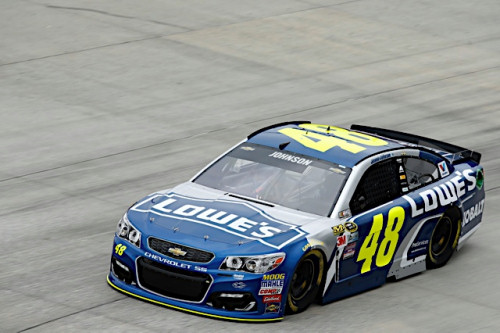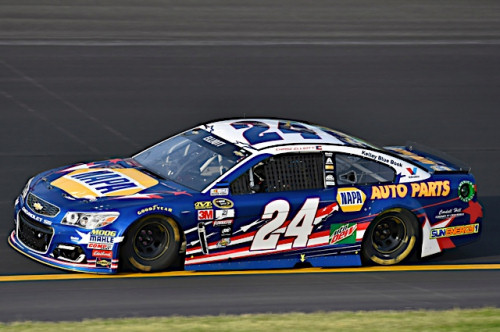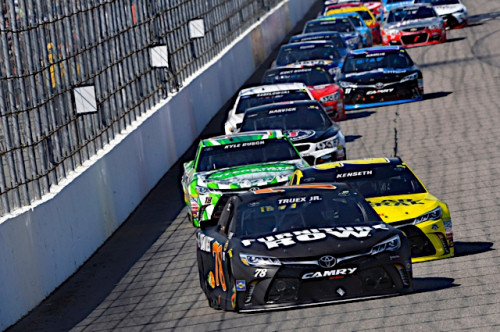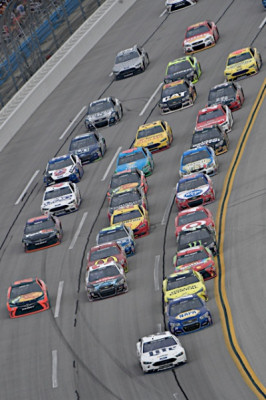The Way It Is/ A look at how Hendrick Motorsports operatesby Gordon Kirby |
 Hendrick Motorsports is NASCAR's most successful team with eleven championships and 242 wins over the past 33 years. But this season is shaping up to be one of Hendrick's most meager in many years.
Hendrick Motorsports is NASCAR's most successful team with eleven championships and 242 wins over the past 33 years. But this season is shaping up to be one of Hendrick's most meager in many years.
Jimmie Johnson scored the team's most recent win at the California Speedway in March although Johnson and Chase Elliott were very strong at the Chicago Speedway last weekend before Johnson made the mistake of speeding in the pit lane while Elliott was beaten at the end by a resurgent Martin Truex Jr. Hendrick's team has also been coping with Dale Earnhardt Jr.'s struggle with concussion symptoms which have sidelined him for the rest of the year at least. Founded in 1984 by automobile dealer Rick Hendrick the team won three races in its first year and took its first championship in 1995 with Jeff Gordon. The following year Terry Labonte won Hendrick's second championship with Gordon finishing a close second. Gordon went on to win two championships in a row in 1997 and '98 and added his fourth title to the team's growing collection in 2001. Jimmie Johnson joined Hendrick's team in 2001 at Gordon's behest and won an amazing string of five consecutive championships from 2006-2010. Johnson won his sixth and Hendrick's eleventh title in 2013.  © Russell LaBounty NKP Doug Duchardt is Hendrick's general manager and Ken Howes is the team's vice-president of operations. Both report to the team's president Marshall Carlson. Duchardt has been with Hendrick for twelve years while Howes has worked with the team since its early days. "Ken and I work together," Duchardt says. "All the crew chiefs and team personnel are under Ken. He has responsibility for all the race teams. We have about 200 people working under Ken's direction and another 100 or so in the chassis and body shop." Veteran crew chiefs Kenny Francis and Darian Grubb also occupy key roles in Hendrick's team. "Kenny is the vehicle technical director and Darian is the vehicle production director," Duchardt says. "Darian works closely with NASCAR at the track. And then Jeff Andrews manages the engine shop which employs about 120 people." Hendrick started running two cars in 1986, expanded to three cars the following year and became a four-car operation when Jimmie Johnson arrived in 2001. "Fortunately the rules stop us from going to more than four cars," Howes remarked. "Otherwise, we would probably run five cars. Rick started with one, then two cars and we ran three cars for a long time. Then we hired Jimmie Johnson to drive a fourth car. To accomplish that we needed the space and facilities to allow that.  © Matthew T. Thacker NKP Hendrick builds more than 700 engines each year, supplying Hendrick's four cars plus Stewart-Haas's four cars and nine more smaller NASCAR teams. "The requirements from the engine side drives the size of our team," Duchardt says. "We supply our team and eight other teams in the Cup series with engines, plus our Xfinity and Truck teams, plus the development work we do. We use one engine for each race so we're constantly building and developing engines. "We build a dozen new engines for each race while in Formula 1 these days, they're limited to I think four engines per year. For us to have that throughput every week takes a certain amount of manpower and it's no different on the car side because we're going flat-out every week from February through Thanksgiving in November." The team changed its approach to engine-building twenty years ago. "A lot of discipline has been put into the system and there's also been a lot of evolution," Duchardt said. "When Jeff Andrews first came to Hendrick in 1992 there was an engine builder for each car. We bought a camshaft from one supplier, some cylinder heads from another and pistons from another. Each engine builder had different ideas. "But then Randy Dorton took over the engine shop and decided we were going to build one spec of engine for each track. He said we were going to assemble just one spec of engine and that drove some processes that allowed us to improve our quality. I think we have done that for sure. We invested heavily in our metallurgy capability. We have a metallurgy partner in Hexagon Manufacturing Development and the equipment we have and their expertise helps us on that side. "We have one spec of engine for each race. We're pretty fortunate because the engines usually come within half a percent which means three or four horsepower for a 750 bhp engine. I feel like, from top to bottom, the product is pretty tight and consistent. I can't remember a time when someone said those guys must have a better engine. "We've had times when we've had a future spec engine in a car during 'The Chase' with a car that's out of 'The Chase'. That enables us to get some miles on the engine and we've had some comments like, 'Boy, that thing runs! When do we get that engine?' But when we do that, everyone knows what's happening. There's nothing going on behind the scenes. "I'm proud of the fact that while we wish we could have won those championships we're proud that we've had two customer wins with Tony Stewart and Kevin Harvick with our engines. That legitimizes how we do it."  © Lesley Miller / NKP "The car side evolves more frequently and fluidly than the engine shop," Duchardt said. "You try to put processes in the system for the assembly side to make sure that things are properly assembled. But there's a lot more frequent change on the car side so it makes a little more of a challenge as far as keeping the quality up. "I'm not saying we have a problem. It's just the constant churn of that. If you have a piece you want to put on the car you have to make sure you have an assembly drawing for it so you can give the mechanic the correct specs to put it on the car. Each process is documented. "If I look back, in less than ten years we've probably added fifty engineers to our company. So there's all that additional engineering effort that you have to manage, but there's also much more effort required in how you have to present your car to NASCAR for inspection so it's deemed within their specifications. We moved from the 'Car of Tomorrow' in 2007 to the 'Gen 6' car three years ago and NASCAR have tightened up the tolerances on the car build. "We have to hand-build these race cars and be within a hundred thousandth of an inch, whereas in 2007 and before you could be two or three inches off the way they stacked and applied the templates. There's a lot more man hours that go into a car to put it on the trailer to get it to the track." Also, for the top teams the life span of each car is very short. "You either wreck it out of commission or you obsolete it," Duchardt remarked. "If you don't wreck them I would say you can race each chassis three or four times before you have to rebuild them. Some guys have a different philosophy. I think the Gibbs guys go only two races with each chassis. "From a body standpoint you basically have to cut the body off from the door tops down and put a new body on to make NASCAR's templates. With the tolerances we have to meet it almost drives you to hang a new body on the car for every weekend. That's just part of what it takes these days." Duchardt added that most NASCAR teams spend as much time in the wind tunnel as F1 teams. "There are two full-size wind tunnels in the Charlotte area and they stay busy all the time," he said. "The big teams are in the tunnel every week. There's constant work going on all the time whether they're in the tunnel or doing CFD work. It's the same as in every top level of motorsports. Every team is working all the time in the tunnel and in CFD." In recent years NASCAR has made a deliberate effort to forge a better working relationship with its teams. Duchardt has nothing but good words to say about the sanctioning body. "There's definitely been an evolution," he says. "NASCAR's been open to engage the different competition leaders of the teams to discuss how to approach the rules. You try to find a balance of minimizing changes because anytime you make a change the costs go up. "You're also trying to stop something before it gets out of control. We've seen that in different forms of racing. It could be materials that are being used. It could be a concept that drives everyone to invest in something new that you don't want to happen. But if you can come up with that new idea you have that advantage for a certain amount of time." Duchardt admits this reality is difficult for any racer to accept, but as he says, it defines NASCAR's philosophy and way of life. "It's frustrating but you get used to the fact that you may only have some sort of creative thought applied for a certain amount of time before it's reined in," he remarked. "If they don't do that, instead of four cars having it, forty cars have to, and that causes big cost ramifications. That drives frustration from the competitors side, but NASCAR is trying to manage the overall sport. "Having said that, I feel like the dialogue is good, the intent is good, the tone is good, and I think it's getting better as we move on. From the CoT to the Gen 6 car, they keep continually tightening down the rules and the areas you can work, which means you're turning over small stones all the time to try to stack pennies in every area. That's tedious and tough, but that's what you have to do."  © Nigel Kinrade NKP "I think in any series there's a rule book and you have to take those set of rules and interpret them," he observed. "That starts the loop. We do that 39 times each year. It's almost a never-ending feedback loop." Duchardt says a key element in NASCAR is that the teams work at the track in an open garage without any walls separating teams so everyone can see their competitors' cars. "The rule book may not change but NASCAR sets up the garage area so that we work side-by-side with our competitors in points," he said. "We work in very close quarters with our competitors in an open garage where people can see each other's cars and scrutinize what's happening. You can see if somebody else has interpreted the rule differently than we did in being comfortable in going to a certain point. "There's a process of pushing the rules and hopefully finding the right balance between pushing the rules and not going over the line. So it's a combination of understanding what's happening in the garage area and then getting feedback from NASCAR on whether you're fine with what you have or they don't like what's going on and want you to adjust something. "It's not just the black and white in the rulebook it's about a do-able discussion with officials about how they feel like you're interpreting the rules. You constantly navigate in those waters through the whole season." Howes expanded on Duchardt's comments. "There are always questions about what does this rule really mean and there are always grey areas," Howes remarked. "People will use the word cheating pretty freely and to me there's a vast difference. Cheating is cheating. If the rule says it's got to be six inches and you make it six and an eighth, you're cheating. If it says something has got to be six inches plus or minus one-sixteenth then you've got to make it to that spec, plus or minus, whichever is in your favor. You're always working to maximize the rules as you see them. "Any sanctioning body has a problem writing rules because you can only write rules for what you know. It's hard to imagine putting the words into a sentence to define many things. Some rules are clear where there's a dimension but there are many areas that are not quite as clear. People will look at not so much what the rule says, but what it doesn't say. "For example, somebody may say a part moves when it's not allowed to move. That's when it becomes a test with the officials. Is it allowed to move or not? And is it in our favor or not? We will try to maximize the rules and it will be seen and discussed. NASCAR or any sanctioning body will decide that's okay or they will say it's not what we want or envisaged and re-write the rule to make it clearer. "Sometimes it's tough to separate. There's cheating and there's this other aspect to it. We are trying to build the best race cars that we can. You're trying to do a better job than the next guy but there's a clear line for many things. The engine can be this big and if it's bigger than that you're cheating. If it's not 360 cubic inches, that is not a grey area. It's clear that you're cheating." Toyota has been getting steadily stronger in NASCAR with Joe Gibbs's four-car team for Kyle Busch, Matt Kenseth, Denny Hamlin and Carl Edwards, plus Barney Visser's 'satellite' team for Martin Truex. Busch won last year's championship and all four of Gibbs's Toyotas have qualified for this year's 'Chase'. Between Gibbs's four cars and Truex, Toyota has won thirteen Cup races so far this year. Toyota entered NASCAR ten years ago and builds its engines at Toyota Racing Development (TRD) in California.  © Nigel Kinrade NKP "Obviously, they have a strong partner in TRD. You can take a step back and wonder if the Waltrip team's demise helped them because all the effort is directed and focused on one team. That being said, it's up to us to get our house in order and try to respond to that challenge and that's what we're trying to do." Ford has also been very competitive in recent years with Roger Penske's team in particular. Next year, Stewart-Haas switches to Ford after racing Hendrick-built Chevrolet cars and engines over the past eight years. Stewart-Haas won the championship with Tony Stewart in 2011 and Kevin Harvick in 2014. "The Penske guys have done a good job and next year Stewart-Haas will move over to Ford so it will be interesting to see how all that comes together," Duchardt said. "We don't have anyone backfilling for Stewart-Haas. Mr Hendrick has said we're going to keep the resources we have. In other words were not going to cut people. We're going to put them in different areas to improve our program. I see it as an opportunity." I also asked Duchardt and Howes about the human toll of NASCAR's marathon 39-race season which is the longest in any of the world's major sports. "Managing the schedules for each week and each race weekend is about quality of life," Duchardt observed. "The sacrifices it takes people to come and work on a race team is considerable. Over the years Ken and I have seen young guys come in full of energy for a couple of years and in the third year he's got a girlfriend and the next year they're married. By that time, he tells you he doesn't want to do this anymore because it's taking up too much of his life. We've watched this happen many times. "That's part of why we have our own aviation division to try to help with that as much as possible, to help them get home as quickly as possible and help them stay home as late as possible. It's a definite concern. "People who are fans say they would love to do that job. But when you face the reality of going to every race, to every practice session and share a room and a rental car with another guy and do that every week it might look a little different than you thought. If the car's running well you can deal with the guy that's always two minutes late for the van or the roommate who keeps you awake at night. But if it's not running well people can get cranky pretty quickly. "Being on the road and living together on the road isn't an easy thing. It's a whole dynamic you have to deal with. But having said that, typically we don't have that many problems like that to deal with. It's a physical and emotional toll that you just have to be ready for and grind through. It is a grind, no doubt."  © Logan Whitton/NKP "It's a problem as Doug said. You work hard to make it as comfortable as you can for everyone. Eventually, people cycle out. Eventually, I'll cycle out and somebody else will be dealing with it. Just a few well-spaced breaks in the year would make a big difference. Next year I think there are 22 races in a row so it's going to be hard. It's tough. There's that old phrase, 'Yes I'm doing great. I'm living the dream.' When people start to question or doubt you, you have to keep reminding them of that." In closing I asked Duchardt what the biggest challenges are for Hendrick's team. "I'd say our biggest challenge is to continue to develop our cars at a pace that gets us to where we want to be at the end of the season," Duchardt said. "I always remind people that the NASCAR season is a marathon and not a sprint. There's a lot of ebbs and flows to it. "So we're just working on trying to get better. All the other teams are working to try to get better of course, so that means you've got to get better than the next guy to catch up. We're focused on every aspect of the car and engine to try to do that." |
|
Auto Racing ~ Gordon Kirby
Copyright ~ All Rights Reserved |
